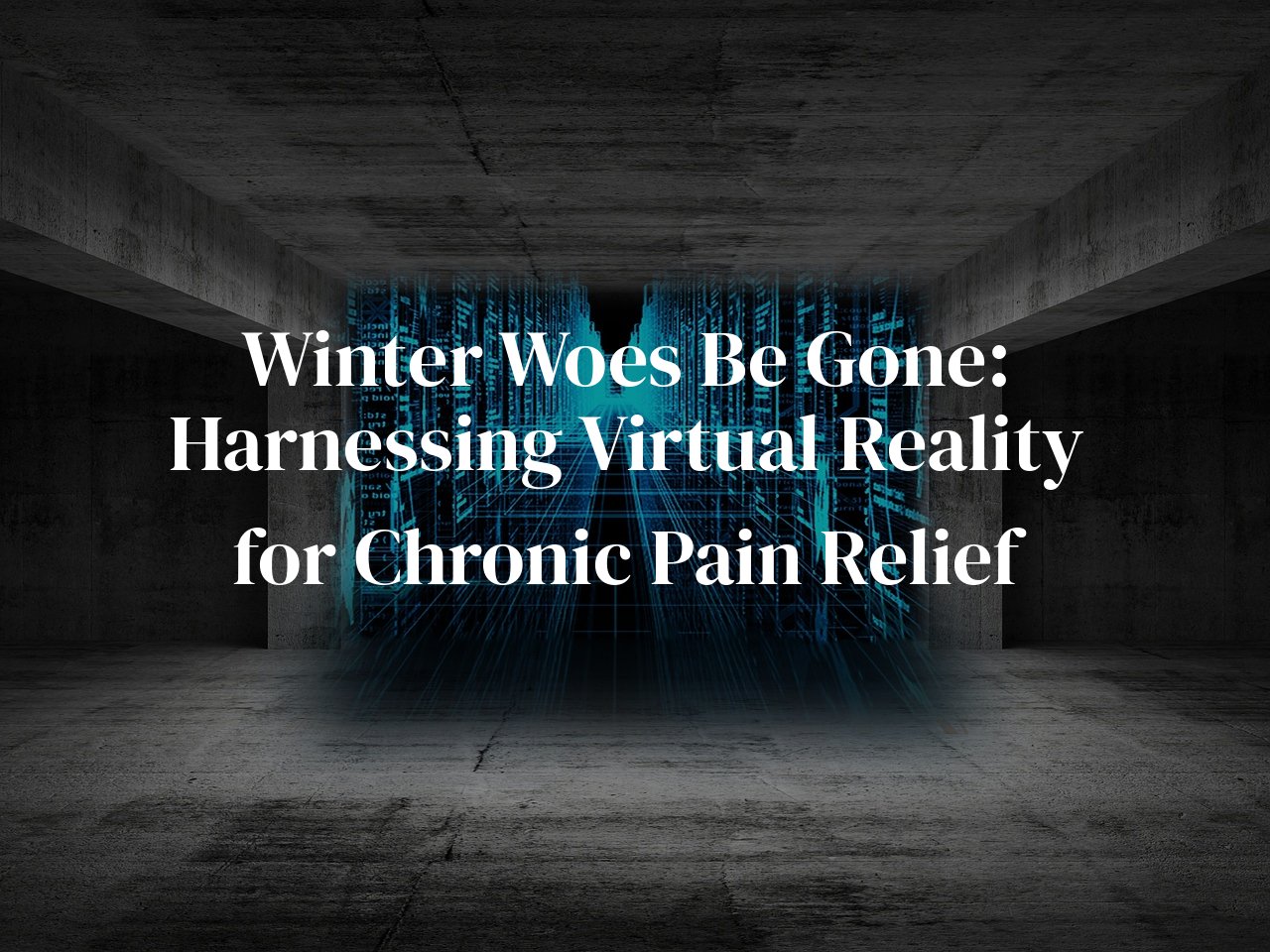
As the frosty winds begin to blow and the daylight shortens, our bodies often react to the changing seasons with discomfort and pain, particularly for those living with chronic conditions. This blog post delves into the innovative approach of using virtual reality (VR) as a tool to manage and alleviate chronic pain during the challenging winter months. Herein, we’ll explore the technicality, feasibility, and therapeutic potential of VR in providing pain patients with a much-needed respite from their incessant discomfort.
By reading further, you’ll uncover insights about how this technology works, its benefits over traditional pain management methods, and practical advice on incorporating VR therapy into your own or a loved one’s pain management regimen. The information provided here aims to equip you with a new perspective on chronic pain treatment and how it can create a transformative experience through the cold season.
Table of Contents
Understanding the Impact of Winter on Chronic Pain
As the seasons transition into the colder, harsher climate of winter, many individuals with chronic pain report a noticeable exacerbation in their symptoms. The reasons behind this seasonal sharpening of discomfort are multifaceted and deeply intertwined with how our bodies react to environmental changes. To navigate these chilling months, it’s crucial to recognize and understand the various ways winter can deepen pain.
Firstly, the drop in temperature is known to affect the viscosity of synovial fluid – the lubricant within our joints. Colder conditions can cause this fluid to thicken, which leads to stiffer and more painful joints, particularly relevant for those with chronic conditions like osteoarthritis. Secondly, we must consider barometric pressure, which typically drops before cold weather sets in, leading to the expansion of tissues and consequently, increased pain sensation often reported by individuals with chronic pain syndromes.
Additionally, winter’s abbreviated daylight hours contribute to a deficiency in Vitamin D – a vital component for bone and muscle health. A lack of sunlight hampers our body’s ability to synthesize this vitamin naturally, potentially intensifying chronic pain symptoms. Moreover, the instinctive response to cold is to tense up our bodies, an involuntary action that can lead to increased muscle tension and pain. While this reaction is a temporary protective mechanism, it’s counterproductive for those already in persistent pain.
Beyond the physiological responses, the psychological impact of winter shouldn’t be underestimated. Reduced sunlight and gloomy weather can lead to feelings of depression or seasonal affective disorder (SAD), which are closely linked with increased perception of pain. The interplay of mind and body means that emotional well-being is as significant as physical health in the management of chronic pain.
In essence, being armed with the knowledge of how and why winter can amplify chronic pain conditions is a pivotal step in seeking appropriate treatment options and adopting lifestyle changes that may mitigate these seasonal challenges. Employing virtual reality as an innovative solution is one such promising avenue explored in the succeeding sections of this discourse.
VR Technology: A New Horizon in Pain Management
The advent of Virtual Reality (VR) technology signposts a revolutionary shift in the therapeutic landscape for chronic pain, particularly during the frigid throes of winter. This immersive tool transcends traditional pain management paradigms, offering an innovative and engaging way to mitigate the discomfort often intensified by the season’s cold grip. By stimulating the visual and auditory senses, VR facilitates a form of digital escapism that can produce profound analgesic effects.
In the battlefield against chronic pain, VR enlists a range of applications, each tailored to ensconce patients in alternate realities that divert their attention from pain. Distraction therapy via VR, for example, immerses patients in environments ranging from tranquil beaches to serene forests. This not only engenders a sense of calm but can also trigger the release of endorphins – the body’s natural painkillers. Moreover, VR can be designed to include gamified rehabilitation exercises that promote physical therapy and conditioning with an element of fun, thus potentially enhancing adherence and outcomes.
Moreover, VR can be tailored to cognitive-behavioral therapy (CBT) techniques, enabling users to engage in guided meditation and deep-breathing exercises that promote relaxation and pain management. The interactivity offered by VR introduces this therapeutic approach in a more engaging and personalized manner. Additionally, biofeedback through VR presents another front in the war on pain, enabling patients to visualize and consequently learn to modulate their physiological responses to pain, such as heart rate and muscle tension.
Virtual reality’s capacity to transport the mind and influence the body’s pain perception does not stop at simple distraction. It also integrates with pain education modules, helping patients understand and visualize the mechanisms of pain, which empowers them to manage their symptoms more effectively. This immersive education can reshape a patient’s cognitive responses to pain, altering pain’s subjective and emotional impact.
The evolution of VR technology continues unabated, with innovations in haptic feedback and augmented integration promising more nuanced and lifelike simulations. These advances in VR equipment add another layer of sensory engagement, rendering an even more compelling experience that can have significant implications for pain modulation. For those ensnared by the relentless clutches of chronic pain, VR stands as a beacon of hope, a technology that not only pledges relief but also the restoration of life’s vibrancy, dimmed by pain, one virtual experience at a time.
The Mechanism: How VR Influences Pain Perception
The juxtaposition of brisk, wintry weather and the agonizing pangs of chronic pain can leave many feeling ensnared in a relentless cycle of discomfort. Enter the technological marvel of Virtual Reality (VR), offering a promising reprieve from this chilling predicament. At the heart of its efficacy lies its ability to weave a captivating tapestry of sensory experiences, effectively altering pain perception. VR’s engrossing worlds engage the mind, drawing its attention away from pain signals and immersing it into an alternate, often tranquil reality.
Further delving into VR’s mechanistic underpinnings, we encounter the concept of ‘immersive distraction.’ This facet of VR technology is potent; it monopolizes the brain’s attentional bandwidth with a deluge of stimuli. The very act of navigating a VR landscape can saturate the senses, overshadowing the neural pathways through which pain travels, resulting in a remarkable diminishment of experienced pain.
Moreover, VR can catalyze the release of endorphins, establishing a natural blockade against pain transmission. This is essentially akin to the body’s intrinsic painkillers being summoned forth by the engaging and often exhilarating scenarios presented in the VR environment. Adding to this, VR’s potential to modulate pain is reinforced through its capability to create biofeedback loops. Users can be taught relaxation techniques and given real-time indicators of their physiological state, enabling them to exert greater control over their pain responses.
The real magic, however, unfolds within the realm of neural plasticity. VR therapies can foster the rewiring of pain pathways in the brain, a phenomenon known as ‘cognitive restructuring.’ Through repeated VR sessions, the brain is trained to reframe the context of pain and reduce the psychological and emotional weight it bears. Consequently, chronic pain sufferers witness a dilution of pain’s impact, easing their winter woes and heralding a season of renewed comfort and joy.
Undoubtedly, the potential of VR as a novel analgesic is vast and still burgeoning. While the individual elements of immersive distraction, endorphin release, biofeedback, and neural plasticity play their respective roles, it is in their synergistic dance that VR truly shines as a beacon of hope for those entwined in the cold grasp of chronic pain.
Real People, Real Relief: Success Stories with VR
We often hear about technological advancements from a theoretical standpoint, but it’s the human stories that truly illustrate the impact. Virtual Reality (VR) in pain management is more than just a promising study; it’s a source of real-world triumphs over chronic pain. One of the most compelling examples comes from Emily, a young woman suffering from complex regional pain syndrome. The icy grip of winter exacerbated her agony, making even the simplest tasks seem Sisyphean. However, through a VR pain relief program, Emily was able to immerse herself in a serene virtual environment that significantly reduced her pain levels. The program utilized biofeedback to help her understand and control her pain response, transforming her winters from a time of dread to a season of manageable discomfort.
Another case where VR made a stark difference is with Michael, a veteran grappling with chronic back pain. Traditional painkillers were only marginally effective and came with concerns of dependency. The introduction of VR therapy into his routine brought an unexpected reprieve. The immersive games and experiences specifically designed to distract from pain provided Michael not just a temporary escape but a lasting reduction in his pain’s intensity. Real-time engagement in VR activities, especially during the cold months, helped maintain his mobility and lifted his spirits, proving invaluable in his ongoing battle against chronic pain.
Elderly individuals are not immune to the benefits of VR either. Take, for instance, Susan, a septuagenarian with arthritis. The winter cold made her joints stiff and achingly painful. VR therapy sessions, which transported her to warm virtual beaches, allowed her to engage in gentle, controlled movements that were both therapeutic and enjoyable. The combination of visual stimuli and interactive exercises effectively distracted her from her chronic joint pain, demonstrating VR’s potential to elevate the quality of life for seniors living with pain.
These are just snapshots of the real-life impacts of VR on individuals enduring chronic pain. What stands out in each narrative is not only the alleviation of physical discomfort but also the emotional uplift. VR’s immersive qualities forge an empowering escape, a mental sanctuary, where the chilling effects of winter on chronic pain are replaced by individualized worlds of relief. As each story unfolds, it’s clear that VR is more than a mere gadget; it’s a tool of hope and healing, a digital balm for the persistent sting of chronic conditions.
Integrating VR into Your Pain Management Plan
As the frosty tendrils of winter reach out, those with chronic pain may feel an intensified grasp on their comfort and mobility. With a growing body of evidence suggesting the efficacy of virtual reality (VR) in pain management, it’s important to consider a systematic approach for integrating this innovative technology into your existing pain management plan. Embracing VR means stepping into an immersive world that can offer a well-needed reprieve from discomfort. Let’s navigate together the steps to merge VR seamlessly with your routine.
Firstly, consulting with your healthcare provider is a pivotal step before embarking on a VR journey. This partnership ensures that VR complements any ongoing therapies and aligns with your unique health profile. Your provider can offer guidance on appropriate VR programs designed for pain relief and help monitor your progress.
Next, select a VR system that best suits your requirements and constraints. Opt for user-friendly interfaces if you are less tech-savvy, or choose advanced devices offering a myriad of features if you’re comfortable navigating high-tech equipment. Comfort is key; the headset should feel like a gateway rather than a burden.
Creating a dedicated VR schedule is vital. Consistency can enhance the benefits of VR, so incorporate regular sessions into your daily routine. Whether it’s a few minutes to disconnect from acute pain flares or longer sessions targeting persistent pain, regularity will be your ally.
Furthermore, diversity in VR experiences can prevent stagnation and sustain engagement. Delve into meditative landscapes, engage with soothing puzzles, or explore virtual physiotherapy. Rotating between different VR apps can keep your brain engaged and may further distract it from the pain signals.
Finally, tracking your progress isn’t just important – it’s empowering. Maintain a pain diary to record your VR sessions, noting any changes in pain intensity or mood. This feedback can reveal patterns, guide future VR experiences, and provide tangible evidence of your journey toward relief.
Winter’s chill doesn’t have to exacerbate your pain. With VR, you can forge a comforting sanctuary, a virtual refuge where pain diminishes, allowing you a clearer path through the cold months. Trust in the process, and let VR lead you towards a life where the sting of chronic pain is but a muted echo.
Conclusion
Virtual reality has established itself as more than mere entertainment; it’s a conduit to healing and comfort amidst the biting cold of winter for those plagued by chronic pain. This post hopefully served as a beacon, guiding you through the principles and personal journeys that highlight VR’s profound impact on managing chronic discomfort. The threshold of a pain-free winter is not out of reach, and with the adoption of VR therapy, the future looks promising for many seeking solace from their pain.



